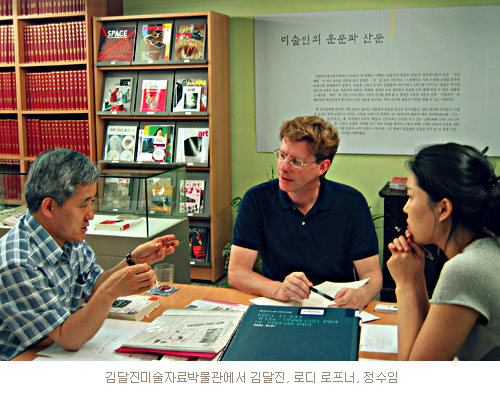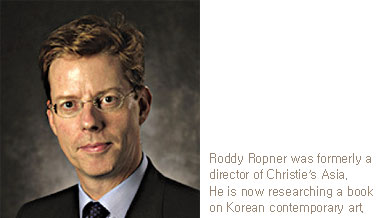본 제목은 본 글의 제목은 서울시립미술관의 최근 전(展)인 '괴물시대(Dissonant Visions)'의 영문 명에서 따왔다. 외부에서 볼 때 하나의 통일된 테마로 한국 미술시장 상태를 보는 것은 힘들다. 나는 이것을 긍정적 정세로 파악한다. 물론 이유를 설명해야 한다. 하나의 통일된 테마는 경향이나 동향(운동)이 자국 시장을 휩쓸고 지나갈 때 나타난다. 우리는 중국의 냉소적 사실주의, 정치적 팝, 일본의 아니메/망가, 영국의 yBa를 생각해 볼 수 있다. 그러나 지나친 단순화나 존재하지 않는 것에 편리한 이름을 갖다 붙이고자 하는 유혹이 만연하고 있다. 하이퍼리얼리즘 같은 카테고리나 한국전통예술이나 미디어의 영감과 관련 된 작업들은, 매우 다양하고 개인적인 작품의 대다수 한국작가들을 적절하게 설명하기 힘들다. 시장을 볼 때 이것이 시장의 모든 구성요소를 볼 수 있게 도와준다. 어떠한 마켓이건 다양한 요소들로 구성됐을 때 더욱 번영하고 번성할 수 있다. 갤러리, 경매회사, 박물관, 아트페어, 비평가, 매거진, 예술학교, 아카이브는 물론 예술가와 콜렉터 들이 건강한 예술시장의 필수 요소이다. 하지만 그것들이 조화를 이룰 필요는 없다. 경쟁은 이들을 더욱 창조적이게 한다. 제3자의 시선에서 볼 때 서울은 번영하는 시장의 모든 필요 요소를 가지고 있다.

먼저 “하드웨어”를 보자. 한국화랑협회에 등록된 100여 개 이상의 상업 갤러리들과 이의 두 배의 등록되지 않은 갤러리들이 있다. 두 개의 대표적 경매회사와 작은 경매회사들이 있으며, 한국 박물관협회에 등록된 500개가 넘는 박물관들이 있다. 한국에서 가장 높이 평가되는 아트페어인 KIAF가 있다. 수많은 출판사와 평론가들의 리뷰, 프로모팅, 작가나 전시들에 관한 해석을 제공하고 있다. 서울의 예술대학들 특히 서울대와 홍익대는 국제적 명성을 얻고 있다. 한국의 작가들은 뮤지엄, 갤러리나 예술공간들을 통해 전시를 할 수 있다. 이들 중 어떤 것들도 당연히 여겨지지 않는다. 그것들이 보여준 괄목할만한 성과들은 특히 지난 15년 동안 한국 미술시장의 성숙된 단계로의 발달을 도왔다.
다음으로 “소프트웨어”를 예술시장과 연관해 생각해 보자. 지금 한국 미술은 해외의 지속적인 관심의 시간을 보내고 있다. 최근 로스앤젤리스 카운티 뮤지엄과(당신의 밝은 미래: 한국 현대작가 12인전), 싱가포르 아트 뮤지엄(모더니티와 한국미술을 넘어)에서 전시가 열렸다. 근래에는 런던의 사치갤러리(코리안 아이: 문 제너레이션)가 한국 현대미술전을 개최했다. 매번 서울을 올 때마다 나는 장난감가게에 들어선 어린아이 같은 흥분을 느낀다. 나는 혼자서 삼청동, 인사동, 강남 등의 많은 전시를 커버 하기에는 불충분한 시간임을 깨달았다. 하지만 조사 후 나는 다소 실망감을 느꼈다. 널리 종합 하기에는 작가들의 작업이 너무 얇게 퍼져있었다. 한국과 외국에 있는 갤러리, 뮤지엄, 옥션들이 같은 작업들로 경쟁하고 있었다. 몇 년 전 까지 흥분시키던 작가들의 작업들이 지금은 부자연스러워 보였다. 물론 이것은 세계 시장의 공통 문제이다. 그래도 나는 상상력을 자극하는 전시들을 소망할 수 밖에 없다. 한국작가이건 외국작가이건 여부에 상관없이 지난 몇 년간 진정 흥미로운 것들을 떠올리기 힘들다. 국립현대미술관에서 있었던 휘트니 비엔날레전은 한국미술시장에 큰 영향을 끼쳤다고 언급되지만 1993년에 있었던 전시이다.
여기에 시장의 딜레마가 있다. 내가 크리스티에서 일한 초기 당시 살아남기 위해서는 세계적 관점이 필요하다 배웠다. 1990년 중반쯤 중국의 엔틱품을 다루는 영국의 100년 이상 된 유서 깊은 세 곳의 갤러리들이 문을 닫았다. 그들은 유럽과 미국에서 아시아로의 시장의 변화를 예측에 실패했다. 반면에 현재 미술시장에서 그들의 결정이 큰 재배력을 차지하는 소더비와 크리스티는 대략 40년 전 본거지인 영국을 넘어 유럽, 미국, 아시아, 그리고 더 최근 중동으로 확장했다. 한국의 갤러리 또한 끊임없이 국내외에 작가와 작품을 홍보해야 한다.
물론 많은 한국 갤러리들의 해외 박람회에 가입하고 한국미술을 활성화하는 길을 만들어 나가고 있다. 이것은 한국 시장의 지속적 성공을 위해 필수적이다. 동시에 많은 콜렉터들이 한국에 오게 북돋아야 한다. 나는 종종 한국과 한국미술이 새로운 세대의 콜렉터들에게 알려져 있지 않다는 것에 놀라고는 한다. 그들은 한국 현대미술에 관심을 보이지만 한국에 오는 것은 드물다. 그들은 거대한 규모의 서울 특히 서울의 중심에서 매우 먼 국립현대미술관을 가는 모험을 결정해야 한다. 그리고 언어장벽이 억제책이 될 수 있다. 많은 미술자료들이 한국어로 생산된다. 이해할 수 있는 부분 이지만 외국 콜렉터들의 한국미술의 폭넓은 이해를 돕는 데는 도움이 되지 않는다. 반면에 나는 넓은 아량과 참을성 친절 등이 방문객을 향하고 있다는 점을 이야기하고 싶다. 매 방문시 호의 받은 나는 이에 보답을 하지 않을 수 없다. 또한, 한국 미술시장이 국제적 역할을 하고 싶다면 위치의 정의와 명확화를 위해 노력할 필요가 있다. 주변 나라 시장들의 경쟁이 늘어나면서 참여를 이끌어내는데 더욱 힘들 수 있다. 홍콩 아트페어가 불과 2년 만에 메이저 아트페어로 자리잡았다는 것을 생각해보자. 한편 서울 포토페어는 이러한 종류의 첫 번째 페어라는 황금 같은 기회에서 틈새시장으로 성장할 수 있는 절호의 기회를 만들 수 있다. 예술시장이 어떤 응답을 줄 것인지는 이러한 도전들의 미래의 성장과 안정성에 따라 결정될 것이다. 만약 조화되지 않은 목소리들(불협화음)이 조화의 부족을 의미한다면 이것은 잘못 이해된 것이다. 조화 없이도 창의력과 열정이 있을 수 있다. 이것들이 한국 예술시장의 발전을 유지하는데 중요한 요소이다.
- 로디 로프너(Roddy Ropner, - ) 크리스티 아시아 파트 디렉터 역임. 현재 한국 현대미술에 관한 도서를 연구 중.
I have borrowed the title for this essay from the recent exhibition at the Seoul Museum of Art whose English title is “Dissonant Visions”. In looking at the Korean art market from the outside it is hard to find a single unifying theme that captures the current state of the market. I find this to be a positive state of affairs. I should explain why. There may be occasions when a mood or movement sweeps through a country’s market. We might think of “Cynical Realism” and “Political Pop” in China, Anime/manga in Japan, “Young British Artists” from the U.K. However too often there is a temptation to oversimplify or to find a convenient label where none exists. Categories such as ‘hyper-realism’ or reference to works that find inspiration in traditional Korean arts and media cannot adequately describe the very diverse and individual output of most Korean artists. When looking at a market it helps to look at all its components. Any market is more likely to prosper and thrive if it is comprised of various elements. Galleries, auction houses, museums, art fairs, critics, magazines, art schools, archives and of course artists and collectors are all vital for the well-being of an art market. But they need not necessarily work in harmony. Competition will help them become more creative. From an outsider’s point of view Seoul has all these necessary components for a thriving market.

Let us consider the “hard ware” first. There are reported to be more than 100 commercial galleries registered with the Korean Galleries Association and twice that number which are not registered. There are two leading auction houses and several smaller ones. There are more than 500 museums registered with the Korean Museum Association. KIAF is one of the most highly-regarded art fairs in the region. There are numerous art publications and critics reviewing, promoting, and providing analysis of artists and exhibitions. Seoul’s art colleges, notably Seoul National University and Hong-ik University, enjoy an international reputation. Korean artists are able to exhibit through museums, galleries and art spaces. None of these should be taken for granted. They represent considerable achievements that have helped the Korean market develop to a degree of maturity especially over the past 15 years.
Lets us next consider the “soft ware” in relation to art market. Korean art is now enjoying a period of sustained interest overseas. There have been recent exhibitions at Los Angeles County Museum (“Your Bright Future, 12 Contemporary Artists from Korea”), at the Singapore Art Museum (“Modernity and Beyond in Korean Art”). Currently the Saatchi gallery in London is hosting “Korean Eye: Moon Generation”, a commercial exhibition contemporary Korean art. Each time I come to Seoul I arrive in a state of excitement like a child in a toyshop. I find that there is barely enough time to cover the many exhibitions at galleries around Samcheongdong, Insadong and in Gangnam let alone the museum exhibitions. After a survey of these however I often feel somewhat disappointed. To make a broad generalization it seems that the artists’ work is now being spread too thin. Galleries, museums, and auctions in Korea and abroad are competing for the same works. The work of artists that used to excite a few years ago is now looking strained. Of course this is a situation common to markets around the world. At the same time I can’t help wishing for exhibitions at museums that would stir the imagination. No matter whether these are of Korean or foreign artists? but it is hard to recall something genuinely exciting in recent years. The Whitney Biennale shown at the National Museum of Contemporary Art is cited as an exhibition that had a profound effect on the art market in Korea but this took place in 1993.
Here in lies a dilemma for the market. I learned early on in my career at Christie’s that in order to survive one needs to have global perspective. Around the mid 1990’s three venerable English galleries dealing in Chinese antiques each with a history of more than 100 years finally closed their doors. They had failed to anticipate the shift in the market from Europe and the US to Asia. On the other hand Sotheby’s and Christie’s current dominance of the art market in large part stems from their decision, roughly 40 years ago, to expand beyond their home base in England and develop the markets in Europe, the US and Asia and more recently the Middle East. Korean galleries also need to assiduously promote the artist they work with both at home and abroad.
Of course many Korean galleries have been making their way overseas joining fairs and promoting Korean art. This is vital for the continued success of the market in Korea. At the same time more could be done to encourage collectors to come to Korea. I am often surprised how little is known about Korea and Korean art amongst the new generation of collectors. They profess an interest in Korea contemporary art but few have made the effort to come to Korea. At the same time those that do venture here need to be determined - the sheer scale of Seoul can be a challenge especially with the National Museum of Contemporary Art currently so far from the centre of Seoul. Then the language barrier can be a deterrent. Much of the material produced is in Korean. This is understandable but it does not help to encourage a wider understanding of Korean art amongst foreign collectors. On the other hand I should note the tremendous generosity, patience and friendliness displayed to towards visitors. In my own case I have received such kindness that after each visit I cannot wait to return. Besides this the Korean art market needs to work hard to define and clarify its position if it wants to play an international role. Increased competition from markets around the region can only mean that it will be more difficult to attract participants. Consider how the Hong Kong International Art Fair has established itself as a major art fair after only two years. One the other hand the Seoul Photo Fair, the first of its kind in Asia provides a golden opportunity to create a niche in a growing market. How the art market responds to these challenges will determine its future growth and stability. If “dissonant voices” imply a lack of harmony this should not be misunderstood. Without harmony there can still be creativity and passion. These are essential ingredients to maintain and develop the Korean art market.
- Roddy Ropner
FAMILY SITE
copyright © 2012 KIM DALJIN ART RESEARCH AND CONSULTING. All Rights reserved
이 페이지는 서울아트가이드에서 제공됩니다. This page provided by Seoul Art Guide.
다음 브라우져 에서 최적화 되어있습니다. This page optimized for these browsers. over IE 8, Chrome, FireFox, Safari